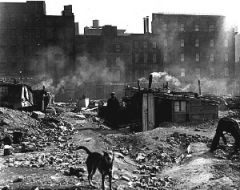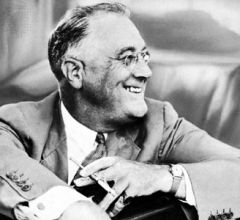![]()
![]()
![]()
Use LEFT and RIGHT arrow keys to navigate between flashcards;
Use UP and DOWN arrow keys to flip the card;
H to show hint;
A reads text to speech;
46 Cards in this Set
- Front
- Back
|
1920s Politics
|
Harding, Coolidge, and Hoover were Presidents.
*Normalcy *Harding Cabinet Scandals *Mellon's Tax Reductions *Economic Boom *Washington Disarmament Conference *Dawes Plan of 1924 *Kellogg-Briand Pact *Hoover elected President *Stock Market Crashes |
|

Herbert Hoover
|
Republican president elected in 1928. After claiming that poverty would be banished from the nation, the Stock Market crashed in 1929 within four months in office.
|
|
|
Bull Market
|
A financial market of a group of securities in which prices are rising or are expected to RISE.
Values of stocks continued to increase during the 1920s. |
|
|
On Margin
|
Borrowing money to purchase stocks on a low down payment
|
|
|
Speculation
|
The process of selecting investments with higher risk in order to profit from an anticipated price movement.
|
|
|
Overspeculation
|
Investors took heavy gambles on hoping that the prices would rise, forcing artificial rises, which led to Bust.
Hoover unsuccessfully tried to curb this with the Federal Reserve Board. |
|
|
Black Tuesday
|
October 29, 1929
Word got around that prices were going to go down, everyone tried to sell withing hours, but it was too late. The stock market crashed. Blamed for Great Depression, but direct connection never proven. |
|
|
Factors of the Great Depression
|
Weak Industries
Overproduction Underconsumption Uneven distribution of income Unstable banking system Weak international economy (Tariffs) |
|
|
Hawley-Smoot Tariff of 1930
|
This was the highest peace-time tariff in US history, causing foreign nations to retaliate by cutting trade through their own tariffs.
|
|

Hoovervilles
|
AKA shantytown, this was the popular name for unused or public lands on which shacks were built named and blamed after the President.
|
|
|
Dust Bowl
|
Soil erosion, drought, dry weather, and high winds caused this period of dust storms that worsened the economic depression for many midwest farmers.
|
|
|
Okies
|
Migrants from Oklahoma who moved West to California, living in makeshift roadside camps and in homelessness
|
|
|
Public Works
|
Government-financed building projects
|
|
|
Relief
|
Money that went directly to impoverished families
|
|
|
Bonus Army
|
WWI Veterans who marched on to Washington DC in support of legislation that would grant them $1000 bonuses early, after the act failed in the Senate, Hoover tried to clear them away from the city, upsetting many Americans.
|
|

Franklin Delano Roosevelt
|
He was a former state senator, assistant sec. of navy, vice-presidential candidate, and NY governor before becoming the Democratic president in 1932, defeating Hoover and advocating a "New Deal."
|
|
|
The Hundred Days
|
Congress passed 15 major acts to meet the economic crisis at a record pace between March 9 and June 16, 1933.
|
|
|
New Deal
|
The name that FDR gave to a sequence of central economic planning and economic stimulus programs he initiated between 1933 and 1938 with the goal of giving aid to the unemployed, reform of business and financial practices, and recovery of the economy during The Great Depression.
|
|
|
Fireside Chats
|
Direct talks by FDR to the American people via radio advocating his policies.
|
|
|
Alphabet Agencies
|
As a part of the new deal, Congress spawned dozens of acts and agencies. Many of these recovery agencies had long names and therefore became known by their initials.
|
|
|
Civilian Conservation Corps
CCC |
March 1933
Employed single men, ages 18-25, for natural resource (forestry) conservation |
|
|
Tennessee Valley Authority
TVA |
May 1933
Built hydroelectric plants and dams aimed at improving 7 Southern states and attracting industry to the South (Still exists today.) |
|
|
National Industrial Recovery Administration
NIRA |
June 1963
This set codes of "fair competition," regulated hours, wages, and prices. Deemed unconstitutional by the Supreme Court |
|
|
Home Owners' Loan Corporation
HOLC |
This agency bought the mortgages of many homeowners and restructured them with lower terms of repayment and interest rates.
|
|
|
Agricultural Adjustment Act
AAA |
May 1933
Reduced agricultural surplus and raised prices for struggling farmers Deemed unconstitutional by Supreme Court |
|
|
Federal Emergency Relief Agency
FERA |
May 1933
Granted federal money to state and local governments to be used to help the unemployed |
|
|
Federal Deposit Insurance Corporation
FDIC |
June 1933
Guaranteed bank deposits up to $2,500 |
|
|
Public Works Administration
PWA Civil Works Administration CWA |
June 1933, Nov 1933 (Respectively)
Provided employment in construction of airports, parks, schools, and roads |
|
|
Securities and Exchange Commission
SEC |
June 1934
Regulated the stock market to avoid dishonest practices |
|

Sen. Huey Pierce "Kingfish" Long
|
Former governor and then-senator from Louisiana, he organized a "Share Our Wealth" campaign to supply each family with $5k. As governor, he improved education and infrastructure. He was assassinated before the 1936 election, where he was a threat to Roosevelt's seat.
|
|
|
Father Charles Coughlin
|
He was a Catholic priest in Detroit who, on his radio show, initially supported Roosevelt's New Deal, but then became impatient as they were too "moderate."
|
|
|
Second New Deal
|
Another series of programs and reforms that FDR hoped would speed up the nation's recovery from the Great Depression.
|
|
|
Works Progress Administration
WPA |
April 1935*
Combated unemployment; created jobs throughout the economy |
|
|
Rural Electrification Administration
REA |
1935*
Brought electricity to isolated agricultural areas |
|
|
Social Security Administration
SSA |
August 1935*
Created unemployment system, disability insurance, old-age pension, and child welfare benefits |
|
|
Public Utility Holding Company
PUHC |
1935*
Eliminated unfair practices and abuses of utility companies |
|
|
Banking Act of 1935
|
1935*
Strengthened the Federal Reserve |
|
|
National Labor Relations Board
NLRB |
July 1935*
Passed by the NLR Act or Wagner Act, it guaranteed workers the right to organize unions without interference from employers and to bargain collectively. |
|
|
Court-Packing Plan
|
Furious that the Supreme Court overturned several of his New Deal programs, he attempted to increase its size by adding a new justice for every unretired member aged 70 and up until there were 15 members. This failed in Congress and ended up hurting FDR's reputation.
|
|
|
Committee for Industrial Organization
CIO |
1935*
Organized industrial unions, skilled and unskilled, under the Wagner Act |
|
|
National Youth Administration
|
June 1935*
It provided work training based on U.S. citizenship and financial need for youth between ages sixteen and twenty-five. |
|
|
Deficit Spending
|
Borrowing money to pay for programs after abandoning a balanced budget. FDR began this in late 1934.
|
|
|
Safety Net
|
Safeguards and relief programs that protected people from economic disaster. This was a result of FDR's New Deal programs.
|
|
|
Relief
|
Short Term
CCC, WPA, PWA, FERA, NYA |
|
|
Recovery
|
Medium Term
NRA, EBRA, AAA |
|
|
Reform
|
Long Term
SSA, FDIC, Wagner Act, TVA, FHA, SEC, REA, Fair Labor Standards Act, Indian Reorganization Act |

